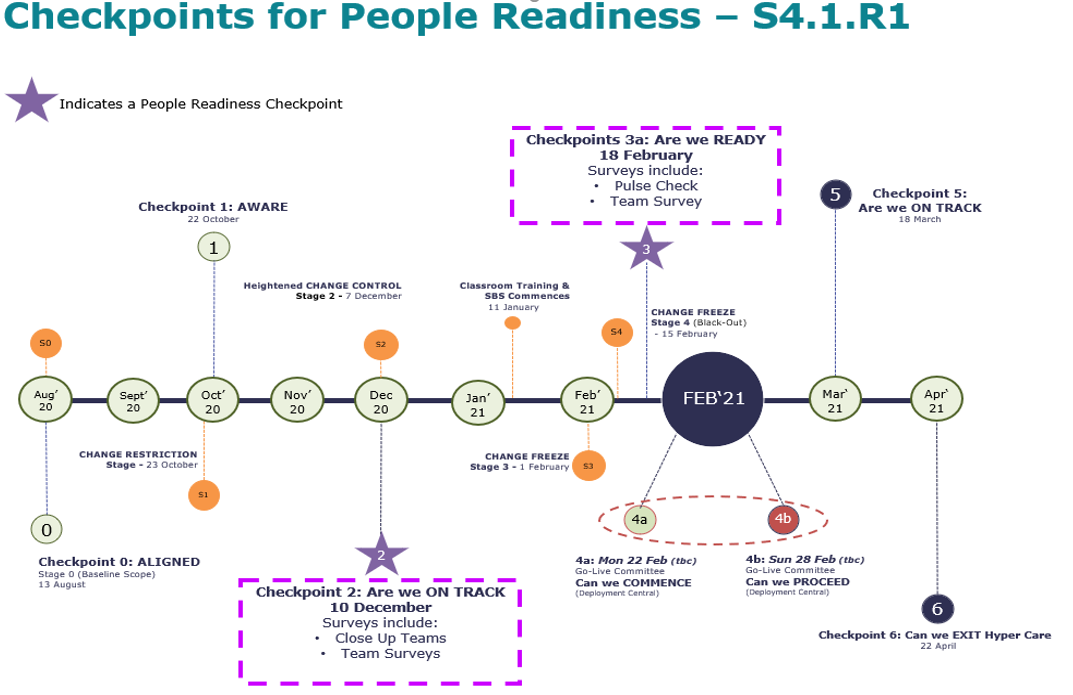To ensure the business, our people and customers were ready for the changes to be implemented, we developed a Readiness Framework, which included a readiness approach for our people, the business and customers. The Readiness Framework is a decision support tool designed to provide status and visibility that the release is “where we planned to be” at a particular checkpoint. The same readiness checkpoints, processes and reporting templates were used for assessing customer, business and people readiness.
An Executive Summary was prepared which reported on an exception basis only. Criteria rated red, light red or amber were included, providing information to decision makers on the potential business and/or implementation risk, with visibility of the 'go to green' plans and residual risk these held for the business.
Assessing readiness
To assess whether our people, operational business and customers were ready for the change, we followed 4 steps. This particular instance refers to assessing customer readiness:
- First, we developed readiness criteria to determine where we wanted to be at a specific point in time. The criteria were specific and measurable over time.
- The next step was to collect evidence: We collected information/readiness evidence through various reports, metrics from marketing and communications activities, metrics from market research measuring awareness, confidence and positivity about upcoming changes, and other research findings such as surveys. Evidence was collected at well-timed checkpoints leading up to implementation, to measure customer ‘awareness, understanding and readiness’ of what’s changing. Evidence had to be auditable in case it was ever needed.
- We assessed the evidence: We conducted assessments of evidence against the readiness criteria (in step 1) to determine how ready customers were for the change.
- Finally, we reported the findings: We reported the findings for each checkpoint back to our governance forums, including any remediation plans to shift customers to an improved state of readiness if required.
People readiness
People readiness informs both business readiness and programme readiness which, (as with customer readiness), is assessed at pre-determined checkpoints. The same 4 steps (above) were used to assess our people’s state of readiness.
The readiness approach:
- helped us understand how prepared we were for go-live
- confirmed the progress on key change management activities
- helped identify gaps and actions to be taken to ensure readiness
- gave us a snapshot of how well things were being implemented from the user’s perspective.
People readiness was assessed using various mechanisms including Pulse check surveys and face-to-face interaction.

Face to face/in-person discussions proved most useful in collecting feedback and helped identify any themes or issues related to people’s readiness for the change. We adjusted our engagement approach based on the most appropriate means of getting feedback, for example, in Stage 4 Release 1, due to the specialised products in scope, we used a combination of 30-minute discussions for our most highly impacted groups, team surveys for our moderately to highly impacted groups and a Pulse Check survey which spanned multiple change groups.
The Pulse check (survey) was the only quantitative people readiness tool used, giving a voice to a large number of highly impacted people.
Business Readiness
To assess business readiness, a few key things were considered:
- Is the business ready to receive the change and what does 'ready' look like?
- Are operational plans in place? What trade-offs need to be made?
- Do we understand the customer contacts that will come about as a result of the change, and how do we plan for it?
- Consider the ‘what if’ scenarios.
General: a few important observations
- We didn’t tell the business what the definition of ‘ready’ was. We took our lead from the business to tell us what 'ready' looked like. This was crucial in getting a successful outcome as the business owned what it meant to be ready.
- We used lessons learnt from previous releases to improve our information gathering and engagement approach.
- When assessing readiness, we took a 2-tiered approach: We had a very clear definition of the RAG (red, amber, green) status, and had a moderation process in place, to ensure the ratings were not skewed by the findings of individual sentiment.
- ‘Readiness’ isn’t a checklist exercise and does not replace your plans. It’s an information tool to assess that you’re tracking well against the plan.
- Readiness checks were ongoing and formed part of the journey people were on as part of the programme.

